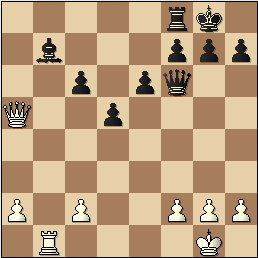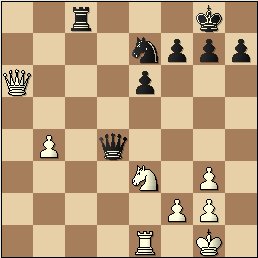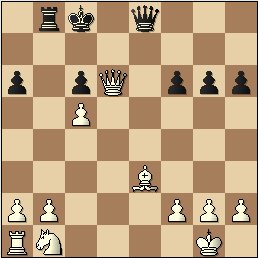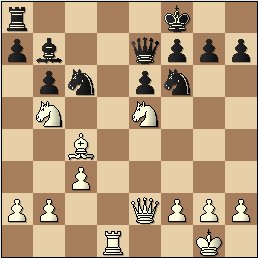Watch
your back …rank!
Back rank checkmate is rather unique attacking situation
where one doesn’t really need many pieces to finish the game on the spot. No
matter what the material balance is, what other targets and threats are, if one
has a Queen, or even a Rook and the other side has the King stuck on the back
rank (1st for White or 8th for Black), there is always a
chance for a game ending back rank checkmate.
Many tactical operations are based on the back rank
checkmate. Among them elimination of defender, deflection/decoy, skewer etc…
It is amazing, how the situation can turn 180 degrees in a single move because
of the back rank problem. In fact, in my new book Chess
Exam Tactics, I list Back rank amongst the 6 critical Motives or reasons
for combinations.
Here is an example from a recent game of my student:
 |
Black to move
Black is dominating – he has an extra Bishop and a
Pawn. White has very little to show for this material disadvantage.
Now, take a note that both Kings are stuck on the back
ranks. Well, one may say -
“So what? There are no threats!” And this is true; but watch what
happened next.
Black was worried about the Bishop being threaten
(which is not true, because after 1.Rxb7 Qa1+ and Black has a forced
checkmate). Instead of improving his pieces or making a safe move like 1…h6,
Black played 1…Ra8?? And after 2.Qxa8+ Black is lost on
the spot! (2...Rxa8 3.Rb8+ Qd8 4.Rxd8#)
|
Once
you notice a back rank problem, seek ways to arrange use it via tactical
strikes. Here is example from my game back from Ukrainian championship
1986 against Kabatyanksy (you may recall it from my book Chess
Exam and Training Guide)
 |
White to move
I have White pieces and I don’t have any back rank
issues (my King has h2-sqaure), but Black does have a problem. Although it
doesn't seem easy for White to get to the back rank.
The task in hand was to get rid of the Ne7 and I
found the solution – 1. Nf5!! Black resigned. After 1…exf5
2.Qxc8+ Nxc8 and, suddenly, the Rook on e1 has its path to e8 cleared – like a
magic, all three pieces (Ne3,Pe6,Ne7) have vanished and the defender (Rc8)
is gone as well! 3.Re8#. All other Black's response would lead to losing a
ton of material.
|
The best way to avoid getting in trouble with the back rank
is finding a time to give your King some breezing room by advancing one of the
pawns that protect him. In fact, sometimes it is worth playing even though there
might be other, more lucrative options.
Take a look at another recent game of my student (rated
under 800):
 |
White to move
It is obvious that White is easily winning. The Fritz
may spend 1/10 of a second and say 1.Qxf6 giving White 9.8 points
advantage. A master may spend 1 second and play 1. Nc3.
I was very pleased to see a young child play 1.h3
here. While it is not the best move here, this shows a disciplined
approach and understanding of the back rank issues. The rest will come
with experience.
|
Here is an example from my game against GM Rohde from
2002 US Open
 |
White to move
I have White pieces, and, after a short thinking,
I played 1.h3.
I can’t say I recall what I was thinking, but
here is what my notes say (thank you ChessBase for helping to preserve my
games!) – “Just a prophylactics. I didn't feel like I have any forcing
opportunities, so I solved the back rank problem.” Just like that – a
very basic idea!
Some 12 moves later we were down to the R+B vs.
R+N and his Rook made its way to e5 aiming at e1. I was happy I could just
win a pawn with my Rook and didn’t have to waste a move there since I
had Kh2 available. |
Summary: always pay attention to the back rank mate
opportunities, no matter how difficult it might be to arrange. If you can afford
to spend a move securing an escape square, it might be well worth doing instead
of a more active move. When practicing using your favorite book on Tactics or
software, such as CT-ART, pay attention to various problems that are based on
bank rank checkmates and memorize the ideas.
If you want to know how good are your tactical
skills when dealing with the Back Rank issues, one of the 30 rating reports in
my Chess Exam Tactics will
tell you just that as well as provide with training suggestions.
====================================================================
What do you think about this article? For comments send email or this
form
More on chess training (serious and enlightening)
Copyrighted @ 2007 Igor
Khmelnitsky
For comments or permission to reprint
please send inquires via email or this
form




